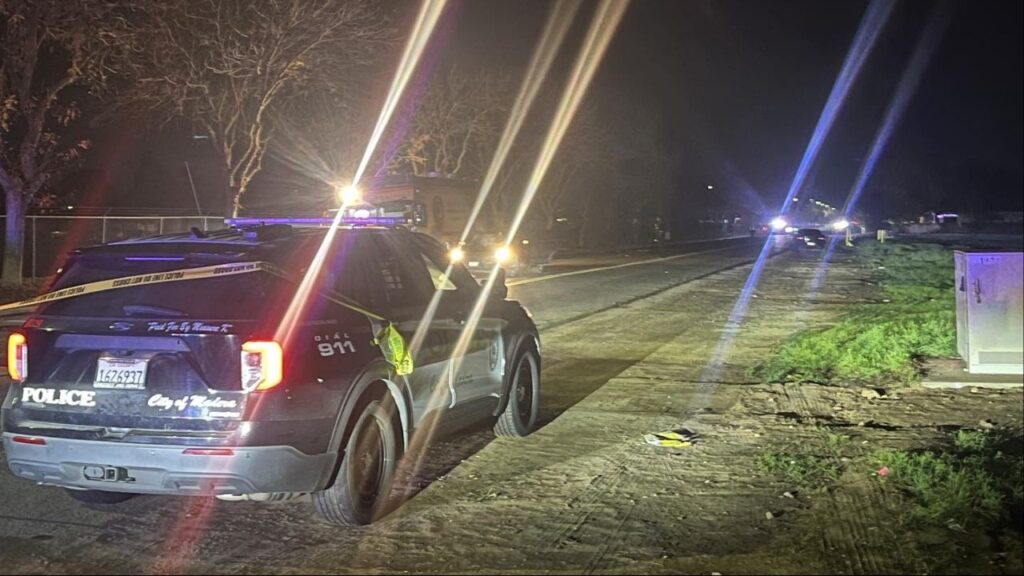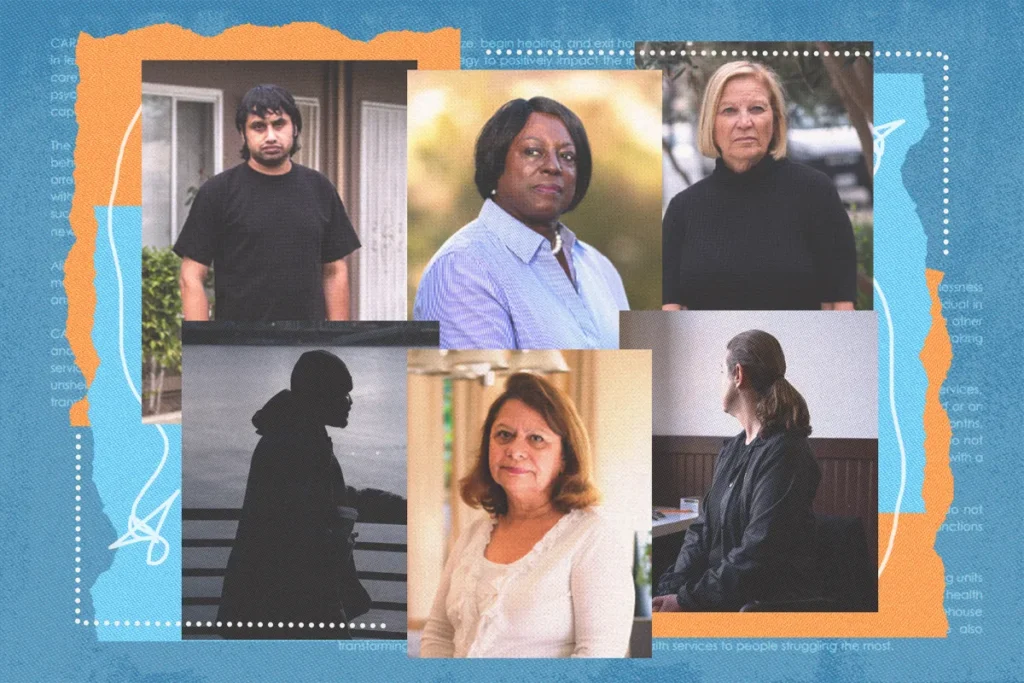Share
Eighteen first-graders are bending their heads over their desks in Room 1 at Valley Oak Elementary School, intent on writing or drawing in their journals. Teacher Julie McGough walks among them, answering their questions and observing their work.
But these aren’t her only students. On a large projection board at the front of the classroom are the faces of three more students who are also members of McGough’s class, and who have continued with distance learning during the pandemic.
In class, the students are wearing masks and are seated 6 feet apart.

As more students return to classrooms for in-person instruction during the coronavirus pandemic, schools are faced with the challenge of determining how best to educate them.
Simultaneous Teaching Piloted
Elementary teachers in the Clovis High West area of Clovis Unified in north Fresno have been piloting “simultaneous teaching” for several weeks and reporting steady improvement, especially as technical issues involving camera and microphone placement are worked out.
But the practice has come under fire in other states, including south Florida where some parents signed petitions seeking to end it, and from a Fresno State education professor who says students are better off with a teacher who can focus on them in one venue, whether it’s in-person or virtually.

“If we’re not giving everybody full due, a full environment to work in, then we’re saying that the people that are less are making the wrong decision. We’re sending that message and that’s not OK.” — Fresno State education professor Kimberly Coy
Doing both at the same time results in a less-than-optimal education for in-person and online students, said Kimberly Coy, an associate professor and coordinator of the doctoral program in educational leadership at the Kremen School of Education.
What some people are calling “simultaneous teaching” is a version of what Coy calls “emergency teaching” that’s been in effect since the start of the pandemic.
One or Other, Not Both
Students are best served by a teacher who can dedicate attention on them, whether it’s in-person or in distance learning, Coy said.

“Kids are very resilient in who they connect with as long as they know that person is genuinely connecting with them. And giving people choice gives them that option to be connected,” Coy said.
“Remember, this is not going to last forever, so — I just feel so sorry for the school districts feeling like this is going to be forever, we’re going to lose education forever. We’re not.”
Coy said equity in education also can be a concern, especially if there is a perception that online education is somehow less valuable than in-person, or that the students receiving that model are somehow lacking.
“The other thing, too, that I worry about especially when you talk about how most kids are face to face and some are online, is that there is a lot of judgment. And so if we’re not giving everybody full due, a full environment to work in, then we’re saying that the people that are less are making the wrong decision. We’re sending that message and that’s not OK,” she said.
“And they’re getting the message that if you were just here, it’d be so much more fun, and their parents are getting that message too, and these parents are making decisions that are very important for their families.”
Kids Want to Be in School
The sight of their classmates back in school instead of learning online has caused some kids who are still online to become very sad and prompted their parents to reconsider their decision to keep them home, Clovis educators said.

Marc Hammack, the area’s assistant superintendent, said one fifth grader cried for two hours on the day her classmates went back to school while she stayed home. The girl’s mother called her teacher later that afternoon and said that although they had chosen the online option, ” ‘Is there any way to get my daughter back in class?’ ” Hammack said. “And the teacher said, ‘Absolutely, have her here Thursday morning.’ ”
Clovis Unified educators are aware of concerns that the simultaneous model is not ideal and that tasking teachers with simultaneous models can impact instruction and learning, he said.
But teachers and parents in the Clovis West area felt it was critical to keep the teacher-student connection intact, whether that’s online or in person, Hammack said.
And given the uncertainty of the pandemic, individual students, whole classes, or their teachers might have to self-quarantine for 14 days on short notice, so keeping students with their teachers this year will help maintain continuity, he said.
Parents Want Kids to Keep Teachers
Tara Scott, co-president of the Valley Oak parent club and mother of three Valley Oak students, confirmed that continuity was important for her and other parents. Changing teachers during the school year would make an already difficult school year even more so, she said.

“They had to adjust to so much, and then to adjust to a new teacher,” Scott said.
But even the current schedule of mornings online for all students and a few hours in the afternoon for in-person instruction is difficult on families, she said. Her preference would be for children to return to school altogether.
But under current state and county health guidelines, students will need to be in school in smaller groupings so as to maintain social distancing.
Gradual Return to School
On-campus instruction is being rolled out gradually in the north Fresno elementary schools, starting with a few grade levels and adding more over the weeks. The goal is to have all students whose parents want them back in school in their seats when the new semester starts after New Year’s Day.

“I really, truly believe that we’re going to become simultaneous teaching experts. It just might take a little time like it did for Zoom.” — Valley Oak principal Julie Duwe
That gradual roll-out has helped teachers and school staff figure out what is working and what needs tweaking, said Julie Duwe, Valley Oak’s principal.
The classrooms already came equipped with ceiling speakers so that students who are online can be heard by the teacher and class, but teachers learned that if they roamed the room to observe students’ work, the kids at home couldn’t always see or hear them if they moved out of range of the iPads or other devices used to broadcast the image. So the district has been testing a camera that follows voices, with a directional microphone.

The classroom equipment includes a “document” camera, where teachers can write out lessons on a whiteboard or line up other materials that can be seen by children at home and in the classroom.
There has been a learning curve for everyone, Duwe said, but it flattens as more people learn from the early adopters.
“I really, truly believe that we’re going to become simultaneous teaching experts,” she said. “It just might take a little time like it did for Zoom.”
Enough Teachers Ready to Return
Valley Oak was fortunate to have enough teachers who felt they would be safe to return to the classrooms, which Duwe acknowledges isn’t the case for all schools.
So, except for the kindergarten classes that were already on half-day schedules, all the Valley Oak classrooms will have simultaneous instruction for the foreseeable future.
To keep class sizes to a maximum of 18 or 19 students, students may need to be split between in-person and online instruction. Depending on the school, students may attend on a hybrid schedule of morning/afternoon or two days in class/three days online.

“As a teacher preparing for that, I also have to take things one step at a time and do what I can do today and try to make tomorrow a little bit better or work out the kinks that I saw today, but not get so upset or worried that it’s not perfect, because it isn’t perfect.” — Valley Oak first-grade teacher Julie McGough
In McGough’s first-grade class, the students have quickly adapted to the new requirements — wearing face masks and keeping 6 feet apart — that are designed to curb the spread of the highly contagious virus.

When it’s time for some outdoor recreation, they leave the classroom and line up on paw stickers (the school mascot is the Wildcat) that are on the ground 6 feet apart, and then stay in their lines as they walk to the nearby playground.
Going to school at the time of coronavirus requires flexibility from teachers and their students, McGough says.
“I’ve told several parents when I did parent-teacher conferences, I think these are students are learning an entire new skill set that we never had as a child or growing up or even as a young adult,” she said. “They’re learning resiliency. They’re learning to change on a dime and to be OK with that change and learning to take things one step at a time, one day at a time.
“And so as a teacher preparing for that, I also have to take things one step at a time and do what I can do today and try to make tomorrow a little bit better or work out the kinks that I saw today, but not get so upset or worried that it’s not perfect, because it isn’t perfect. And we’re modeling that for the students as we go through it, too.”
RELATED TOPICS:
Categories

7-Eleven Inc Says CEO Jeo DePinto to Retire


















